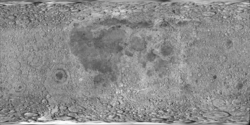Cratere Fourier
Fourier è un cratere lunare di 51,57 km situato nella parte sud-occidentale della faccia visibile della Luna, poco a sudest del cratere Vieta. A nordest si trova il Mare Humorum. Il bordo del cratere è grossomodo circolare, ma appare ovale se osservato dalla Terra, perché visto di scorcio.
| Cratere Fourier | |
|---|---|
| Tipo | Crater |
| Satellite naturale | Luna |
 | |
| Dati topografici | |
| Coordinate | 30°18′36″S 53°06′00″W |
| Maglia | LQ-26 (in scala 1:2.500.000) LAC-92 Byrgius (in scala 1:1.000.000) |
| Diametro | 51,6 km |
| Localizzazione | |

Tranne che a nord-nordovest, la parte esterna del bordo non è molto erosa. Il cratere correlato 'Fourier B' si trova lungo l'orlo orientale interno. Le pareti interne sono relativamente estese, e sono franate per oltre metà del diametro del cratere, formando una sorta di altopiano. Il fondo interno è molto piccolo a causa delle ampie pareti, ed è ben livellato con due piccole formazione da impatto, una a ovest del punto centrale e l'altra vicino al bordo nordest.
Il cratere è dedicato al matematico francese Jean Baptiste Joseph Fourier.
Crateri correlati
modificaAlcuni crateri minori situati in prossimità di Fourier sono convenzionalmente identificati, sulle mappe lunari, attraverso una lettera associata al nome.
| Fourier | Coordinate | Diametro (in km) |
|---|---|---|
| A[1] | 30°12′00″S 49°40′12″W | 32,47 |
| B[2] | 30°32′24″S 52°12′36″W | 10,96 |
| C[3] | 28°33′36″S 52°02′24″W | 13,81 |
| D[4] | 31°31′48″S 50°33′36″W | 20,18 |
| E[5] | 28°42′00″S 50°13′48″W | 14,13 |
| F[6] | 28°49′12″S 52°47′24″W | 14,43 |
| G[7] | 29°24′00″S 51°50′24″W | 10,49 |
| K[8] | 30°02′24″S 54°21′00″W | 13,14 |
| L[9] | 30°12′00″S 52°44′24″W | 4,52 |
| M[10] | 30°22′12″S 53°12′00″W | 3,62 |
| N[11] | 33°28′12″S 56°34′48″W | 9,74 |
| P[12] | 31°07′12″S 55°04′12″W | 9,62 |
| R[13] | 34°15′00″S 51°22′48″W | 7,81 |
Note
modifica- ^ (EN) Fourier A, su Gazetteer of Planetary Nomenclature, United States Geological Survey. URL consultato l'8 aprile 2021.
- ^ (EN) Fourier B, su Gazetteer of Planetary Nomenclature, United States Geological Survey. URL consultato l'8 aprile 2021.
- ^ (EN) Fourier C, su Gazetteer of Planetary Nomenclature, United States Geological Survey. URL consultato l'8 aprile 2021.
- ^ (EN) Fourier D, su Gazetteer of Planetary Nomenclature, United States Geological Survey. URL consultato l'8 aprile 2021.
- ^ (EN) Fourier E, su Gazetteer of Planetary Nomenclature, United States Geological Survey. URL consultato l'8 aprile 2021.
- ^ (EN) Fourier F, su Gazetteer of Planetary Nomenclature, United States Geological Survey. URL consultato l'8 aprile 2021.
- ^ (EN) Fourier G, su Gazetteer of Planetary Nomenclature, United States Geological Survey. URL consultato l'8 aprile 2021.
- ^ (EN) Fourier K, su Gazetteer of Planetary Nomenclature, United States Geological Survey. URL consultato l'8 aprile 2021.
- ^ (EN) Fourier L, su Gazetteer of Planetary Nomenclature, United States Geological Survey. URL consultato l'8 aprile 2021.
- ^ (EN) Fourier M, su Gazetteer of Planetary Nomenclature, United States Geological Survey. URL consultato l'8 aprile 2021.
- ^ (EN) Fourier N, su Gazetteer of Planetary Nomenclature, United States Geological Survey. URL consultato l'8 aprile 2021.
- ^ (EN) Fourier P, su Gazetteer of Planetary Nomenclature, United States Geological Survey. URL consultato l'8 aprile 2021.
- ^ (EN) Fourier R, su Gazetteer of Planetary Nomenclature, United States Geological Survey. URL consultato l'8 aprile 2021.
Altri progetti
modifica- Wikimedia Commons contiene immagini o altri file sul Fourier
Collegamenti esterni
modifica- (EN) Cratere Fourier, su Gazetteer of Planetary Nomenclature, United States Geological Survey.
- (EN) Immagini del Cratere Fourier, in Atlante fotografico orbitale della Luna, Lunar and Planetary Institute.
